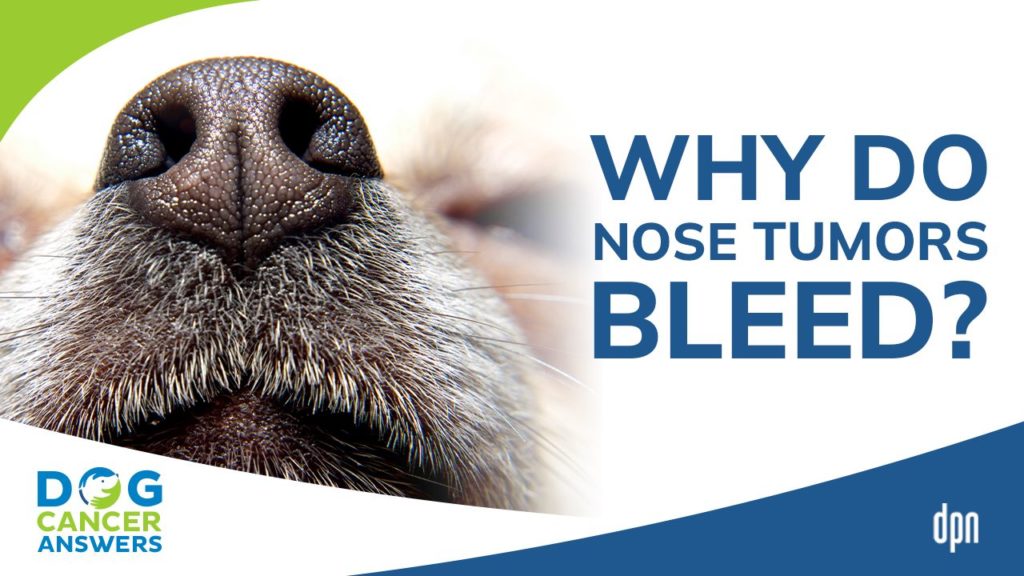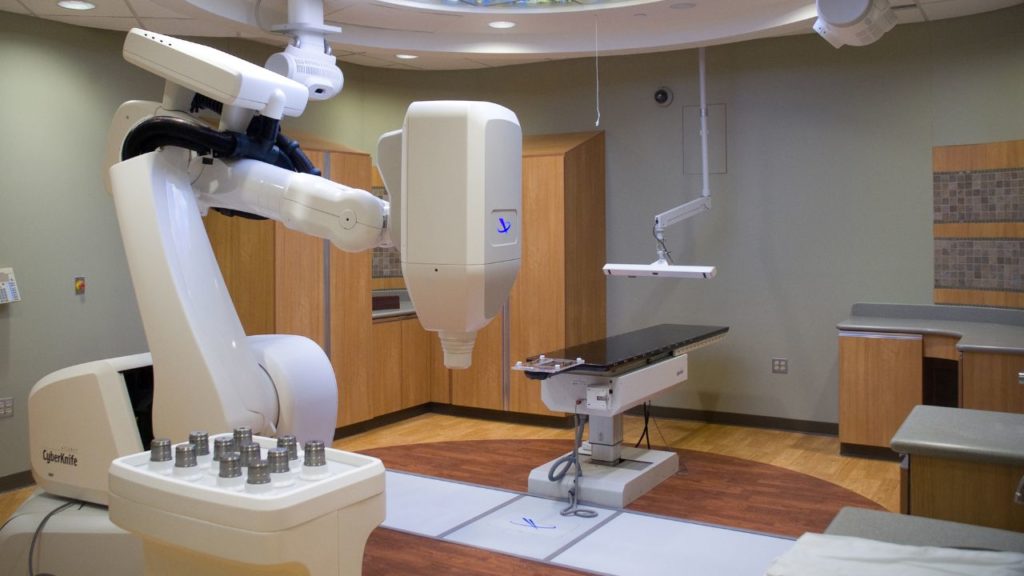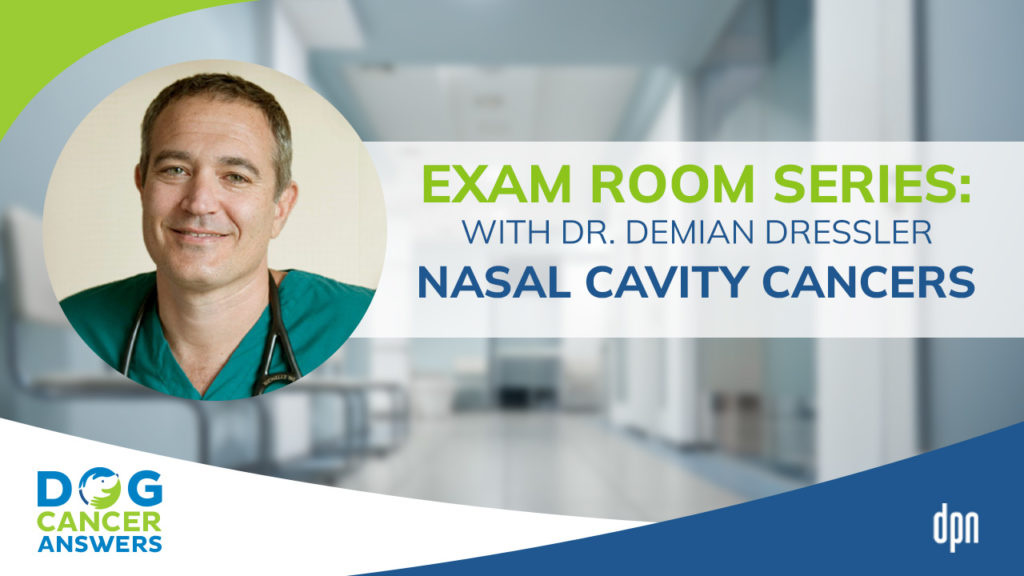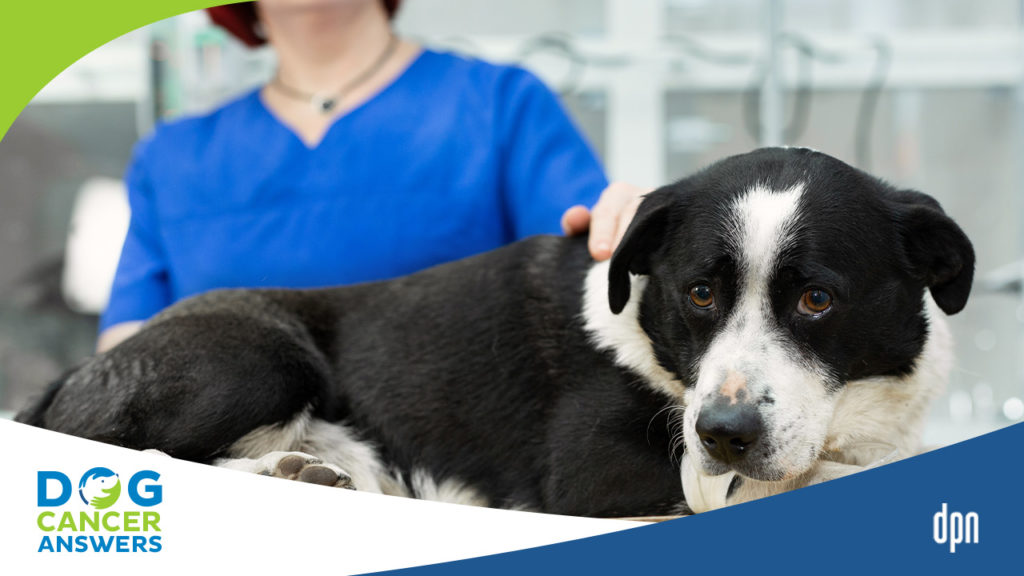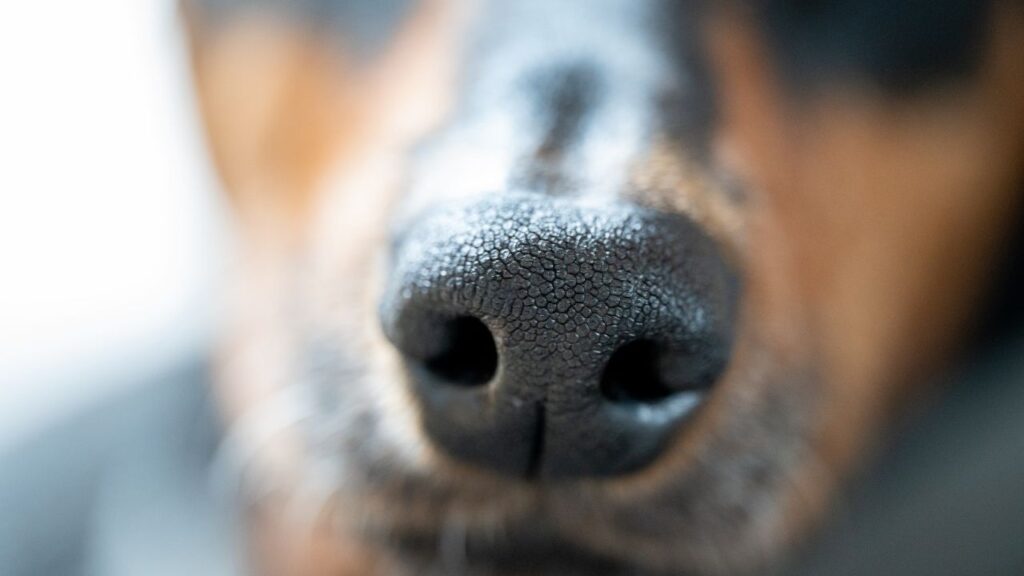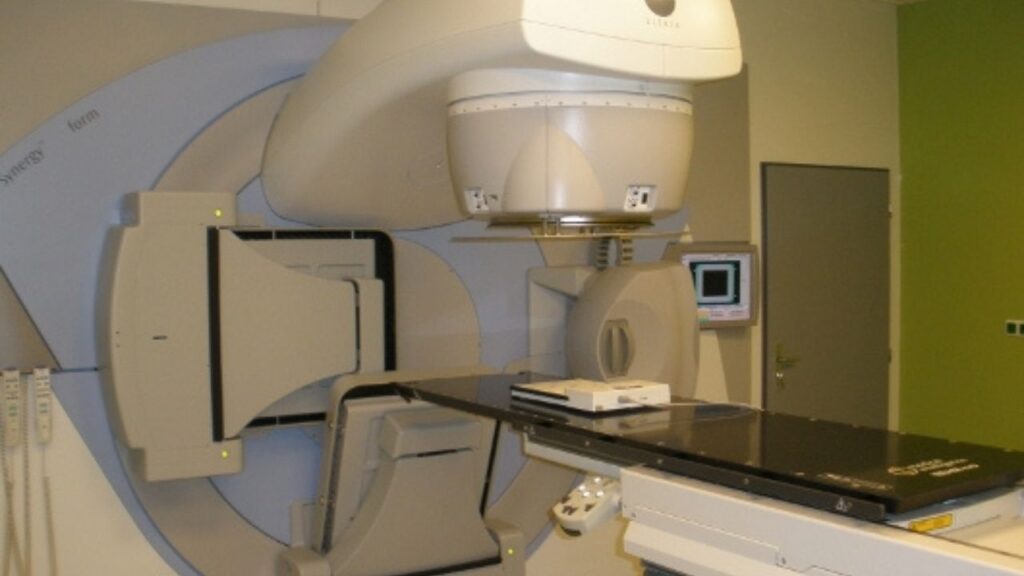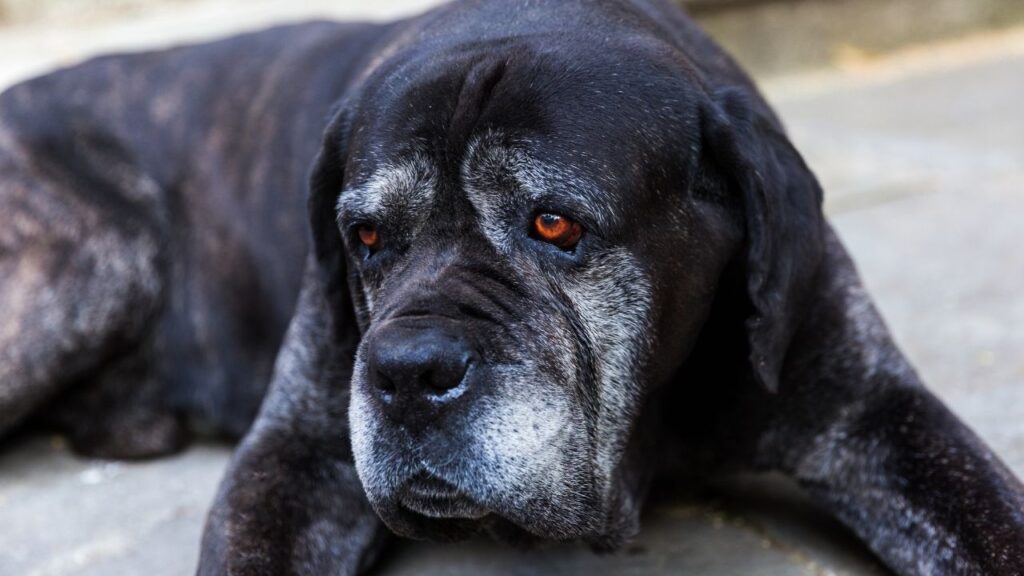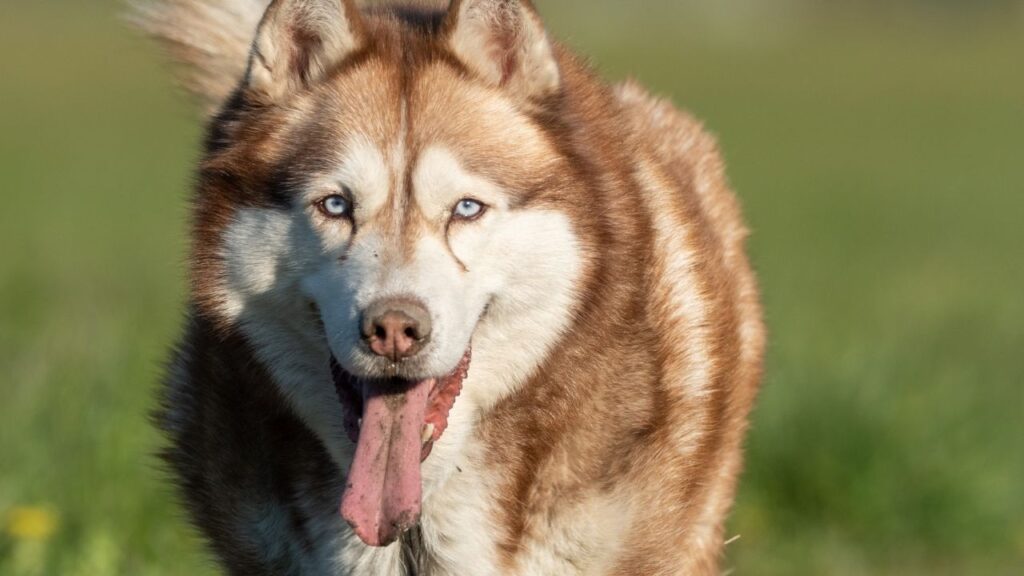Many nasal tumors are cancerous and aggressive. That said, early detection of nose cancer in dogs leads to a favorable response to treatment and a better prognosis.
Key Takeaways
- If treated, dogs can live up to two years with less aggressive nasal tumors, and half a year with severe nasal tumors.
- If left untreated, dogs with nasal cancer live only a matter of three to five months after diagnosis.
- The signs of nasal nasal cancer in dogs vary depending upon the location and tumor type. You may see nasal discharge, sneezing, nosebleeds, or hear weird breathing sounds. More advanced tumors might deform the face or eyes, and some cause the eyes to tear up.
- The first sign of nose cancer in dogs most people notice is an unrelenting nasal discharge.
- Nasal cancer is painful in dogs. These tumors are in tight spaces, and the confines of the skull increase the pressure. They can also block breathing passages, which is another kind of discomfort or pain.
- Nasal cancer in dogs is aggressive locally. In later stages, it metastasizes, usually to the regional lymph nodes, lungs, and brain.
There Are Several Different Types of Nose Cancer in Dogs
There are a variety of different cancer types that can occur in the nasal cavity, so in this article, we are taking a broad view of nose cancer in dogs.
Nearly two-thirds of nasal tumors in dogs are carcinomas, including adenocarcinoma, squamous cell carcinoma, and undifferentiated carcinoma.
The bulk of the remaining tumors are sarcomas, including fibrosarcoma, chondrosarcoma, osteosarcoma, and undifferentiated sarcoma.1
Let’s look at some of these tumor types more closely. Please note that you may see links to other articles that go more in-depth on the less common types of canine nose cancer.
Adenocarcinoma, the Most Common Canine Nose Cancer
Adenocarcinoma is the most common nasal tumor in dogs. 2,3 Overall, adenocarcinomas respond better to radiation therapy than squamous cell carcinoma or undifferentiated carcinoma and have a relatively better long-term prognosis.4
Squamous Cell Carcinoma
Squamous cell carcinoma may involve the nasal planum or other sites covered with squamous epithelium, such as the gums, tonsils, or tongue. It can also originate from the mucosal lining of the frontal sinus and nasal passage.5
Historically, dogs with squamous cell carcinoma don’t respond as well to radiation as dogs with sarcomas or adenocarcinomas do.
Undifferentiated Carcinoma
Undifferentiated carcinoma translates to “undifferentiated tumor.” This refers to a tumor with little or no evidence of differentiation, meaning it does not resemble normal tissue.6
Nasal undifferentiated carcinoma is believed to originate from the Schneiderian epithelium (the membranous lining of the maxillary sinus cavity) or the nasal ectoderm of the paranasal sinuses.
Given the undifferentiated nature of this malignancy, immunohistochemical analysis (see below) is constructive so your veterinarian can confidently formulate a treatment plan.7
Historically, dogs with undifferentiated carcinoma have a poorer outcome after radiation therapy than those with sarcomas or adenocarcinomas.
Chondrosarcoma
Chondrosarcoma is a malignant tumor involving the cells that produce cartilage matrix (the stuff cartilage is made from).9
Dogs with intranasal chondrosarcomas may have better treatment responses than dogs with adenocarcinoma or squamous cell carcinoma8.
Osteosarcoma
Osteosarcoma is a malignant mesenchymal tumor and is the most common primary bone tumor in dogs. Osteosarcoma accounts 6% of nasal tumors.10
Undifferentiated Sarcoma
Undifferentiated sarcoma is a type of soft tissue sarcoma, also called unclassified sarcoma.30
Nose Cancer In Dogs Can Be Hard to Diagnose Accurately
Nasal tumors often represent a diagnostic and therapeutic challenge due to their confined location within the nasal cavities.2
It can be difficult to see them clearly because of the tight space and the complex nasal cavity structures. It can be challenging to treat them for the same reason.
Pain and Nasal Cancer
Most dog cancers do not cause pain, but that’s not the case with nose cancer, no matter the type.
Nose cancer in dogs can be painful. If you think about your own pain when you have something going on in your head, you can assume your dog feels something similar. There is not much “extra room” in the head, and any extra pressure or obstruction can cause discomfort or pain.
You and your veterinarian will want to address pain relief and relieve obstructions as part of your response to nasal cancer (see below).
This is true no matter what type of nasal cancer you face, your ultimate treatment choices, or your treatment goals.
Stats and Facts about Nose Cancer in Dogs
- Tumors of the nose and paranasal sinuses typically are locally invasive and metastasize infrequently.
- Metastasis is more likely in carcinomas and usually occurs late in the disease process.
- Metastasis at the time of diagnosis is seen in approximately 4% of animals but may be as high as 40–50% at the time of death.1
- Common sites of metastasis are the regional lymph nodes, lungs, and brain.29
- If treatment is not pursued, the survival time is 3–5 months after diagnosis.29
- Nasal tumors account for approximately 1% to 2% of all cancers in dogs.2
- Malignant tumors of epithelial origin (carcinomas) comprise 70% of intranasal tumors, with adenocarcinoma and squamous cell carcinoma being the most commonly reported. Sarcomas represent a smaller proportion.11
What Causes Nasal Cancer in Dogs
For many cancers, we often cannot determine an exact cause for cancer development, but nasal tumors do have a likely culprit. Passive exposure to tobacco smoke has been identified as a known cause of canine nasal tumors.12
Of course, nasal cancer is still a multifactorial disease, meaning many things must go wrong for it to occur.
Risk Factors for Developing Canine Nose Cancer
A few factors can increase your dog’s risk of developing nasal cancer.
- Long-nosed dogs living in urban environments are at higher risk for developing nasal tumors.13
- There is a higher incidence in males than in females.4
- On average, dogs are 9.5–10 years old when diagnosed.4
Nasal Cancer in Dogs Symptoms
The symptoms you might notice at home will vary depending on the exact location of your dog’s nasal tumor and the type of cancer he or she has.
Here are some symptoms you might see:
- Chronic nasal discharge (this is the most common clinical finding)
- Periodic sneezing
- Nosebleeds
- Abnormal sounds when breathing
- Facial and oral deformities resulting from the destruction of bone or soft tissues
- Protrusion of the eyeball
- Secondary epiphora (tearing of the eye) may occur if the nasolacrimal duct is blocked29
Dr. Brooke Britton explains why nasal tumors are so prone to bleeding -- and how to help it stop -- in this DOG CANCER ANSWERS episode.
Diagnosing Nasal Tumors in Dogs
It’s important to know upfront that diagnosing nasal cancer can be complicated.
Other diseases of the nasal cavity, such as fungal infections, foreign bodies, and allergies, have symptoms similar to nasal tumors and are more common. Your veterinarian will suspect those and want to eliminate those causes first.
Treating for More Common Problems First
Treating for a fungal infection or allergies first because they are more common, and only considering nasal tumors when those treatments don’t work delays diagnosis. This is unfortunate.
However, it’s also the way that medicine works: we look for and treat the most common cause first, and only move on to other possibilities if that doesn’t work.
As you will see below, the testing necessary to diagnose and treat cancer is much more expensive than treating for simpler and more common issues like allergies.
An Overview of Diagnostics for Nose Tumors
Once your veterinarian has eliminated another cause for your dog’s symptoms, they will use a variety of tests to determine if your dog’s symptoms are caused by cancer and, if so, what type of cancer is present.
Additional testing may include:
- A tissue biopsy for a definitive diagnosis
- Conventional radiography (x-rays) can be helpful, but CT is preferred to get a more detailed look at the extent of the tumor
- If a nasal tumor is diagnosed, three‐view thoracic radiographs of the lungs are recommended to evaluate for metastases
- Needle aspirates of the local lymph nodes are also recommended to evaluate for spread of disease
- Nasal hydropulsion using a high-pressure saline infusion into the nose often yields diagnostic samples (and may also clear some blockages)
- Abdominal ultrasound may be recommended to complete staging1
Staging and Prognosis for Nasal Cancer in Dogs
Staging may impact your dog’s prognosis and which treatment options are available. It may also impact your treatment decisions.
Staging of Nose Cancers
Several staging systems based on radiographic or CT findings have been proposed in canine nasal tumors, but their prognostic significance remains controversial.
The Adams modified staging system developed in 2009 is the most recent system that has been adapted for use.1
- Stage T1: Confined to one nasal passage, paranasal sinus, or frontal sinus with no involvement of bone
- Stage T2: Any bony involvement but no evidence of orbital (around the eye), subcutaneous (under the skin), or submucosal (under the mucous membranes) mass
- Stage T3: Involvement of orbit, subcutaneous, or submucosal mass
- Stage T4: Tumor extension into the nasopharynx (where the nasal cavity meets the soft palate) or cribriform plate (roof of the nasal cavity)
Prognosis for Nose Cancers
The relationship between tumor stage and prognosis is controversial, at least partly due to a lack of consistency in approach and contradictory findings from a few studies.2
With the Adams 2009 modified staging system:
- Dogs with unilateral (one-sided) intranasal involvement confined to the nasal cavity had the longest median survival time of 23.4 months when treated with definitive radiotherapy.
- Those with cribriform involvement had the shortest median survival time of 6.7 months.1
Treating Nasal Cancer in Dogs
Cancer treatment in dogs is usually not about getting a “cure.” Instead, the focus is on improving and maintaining quality of life while hopefully extending the dog’s life beyond what would happen if the cancer wasn’t treated.
The following treatments are commonly used for nose cancer in dogs.
Radiation
Radiotherapy used alone or combined with surgery or chemotherapy is the standard treatment for canine nasal tumors.
Definitive radiation treatment is when a larger radiation dose is given while limiting late radiation toxicity. This theoretically limits tumor repopulation and/or repair.
A step down from definitive is coarse-fraction radiation therapy, which can be used in dogs with nasal carcinomas to alleviate symptoms.2,18,19
Palliative (hypofractionated) radiation therapy protocols are used to improve the dog’s quality of life and increase survival time while minimizing acute radiation toxicity. This approach is often used in advanced disease, when the point is not to cure, but to alleviate pain and buy good quality time. It may also be used for practical and financial reasons.
The median survival time for dogs treated with palliative radiation is generally shorter than for dogs treated with definitive radiation (259 days vs 428 days).
Radiation specialist Jenny Fisher explains everything that happens before, during, and after radiation. A must-listen episode of DOG CANCER ANSWERS.
Surgery
Curative surgery is impossible for nasal tumors, as bone invasion occurs early in the disease. (This is why radiation therapy is the standard of care for these tumors.)
You might be tempted to ask for surgery, but surgical resection as the sole treatment of nasal tumors is not recommended. It offers no advantage over more recent treatments and has significant morbidity (side effects) and mortality (death).
Surgery might be used to debulk a tumor, which means removing part of a tumor to make it smaller. Several studies suggest that surgical debulking before radiation might improve prognosis compared to radiation alone. Other studies refute this, so attempting debulking surgery is usually decided on a case-by-case basis.
A combination of a tumor-reducing surgery followed by radiation therapy for treating nasal tumors has been evaluated but has not been shown to improve clinical outcomes in dogs when compared to megavoltage radiation alone.1,2
Chemotherapy
Chemotherapy is seldom used as the only treatment for nose cancers because there is not much consensus on when chemo is beneficial for nasal cancers, and results have varied widely:
- Different single chemotherapeutic agents (doxorubicin, carboplatin, cisplatin, mitoxantrone, fluorouracil, cyclophosphamide, and L-phenylalanine mustard) or in combination with surgery or radiation have been used, often with disappointing results.2
- Treatment with alternating carboplatin and doxorubicin in conjunction with oral piroxicam may benefit dogs with nasal adenocarcinoma, carcinoma, and sarcoma.15
- Metronomic chemotherapy may be a good option to treat dogs with stage IV nasal tumors.
- Combination of doxorubicin and toceranib phosphate (Palladia) may be a good option for nose cancers.17
Electrochemotherapy (ECT) is a new treatment modality gaining territory in oncology. It consists of the application of an electric field to a tumor to increase the uptake of chemotherapy (bleomycin or cisplatin) that was previously administered locally or intravenously at a very low dose.16
Immunotherapy
Several immunotherapies are being studied to treat both mouth and nose cancer in the veterinary field, including antibody-based therapies,20 biological response modifiers,21 oncolytic viruses22, and vaccines.23
Your oncologist will be up to date on the latest methods or treatments that might be helpful for your dog’s nasal cancer.
Vaccine
A peptide vaccine (EGFR/HER2) may synergize or increase sensitivity to radiation therapy or adjuvant chemotherapy. It may be a viable therapeutic strategy for the treatment of nasal osteosarcomas that overexpress EGFR (epidermal growth factor receptor), and potentially other canine tumors, either alone or as adjunct to other forms of therapy, including radiation and chemotherapy.23,24
Diet
There are no specific dietary recommendations for dogs with nose cancer. Feeding your dog a soft diet may be necessary if the tumor is painful or prevents normal chewing.
For general nutrition for dogs with cancer, please check out our diet articles.
Supplements
An in-vitro study showed that curcumin could enhance the treatment of nasopharyngeal carcinoma.25,26
Yunnan baiyao is an interesting supplement that may help stop bleeding. It may help your dog if their nasal tumor bleeds a lot. Many veterinarians and oncologists are familiar with yunnan baiyao and are comfortable with its use.
Other general cancer supplements may also prove beneficial. Always consult your veterinarian before adding a supplement to ensure that it is a good fit for your dog and won’t interfere with any of her medications or treatments.
Integrative Therapies
Integrative therapies may play a role in your dog’s cancer treatment plan.
Acupuncture may help manage the symptoms of cancer treatment , such as nausea.
One study showed that using various traditional Chinese veterinary medicine modalities improved clinical signs and decreased the mass size in a Pug diagnosed with nasal adenocarcinoma.28
Nasal hydropulsion (mentioned above in the diagnosis section) is a palliative, last-resort treatment in case of obstructive nasal tumors in dogs. A jet of saline is sent up the nasal passages to “blow out” pieces of the tumor. This is also sometimes used to get a tissue sample when a biopsy is hard to obtain. It is generally used when radiation therapy or surgery is not affordable, available, or desired.27
Dr. Narda Robinson explains the hard science behind acupuncture that's been discovered over the last decades in this DOG CANCER ANSWERS episode.
The End Stages of Nasal Cancer in Dogs
Nasal tumors will continue to grow without treatment and may continue to grow even with treatment. Eventually, these tumors severely impact your dog’s quality of life.
Late in the disease, if the tumor extends into the cranial vault and impacts the brain, central nervous system signs such as disorientation, blindness, seizures, stupor, and coma may develop.29
These tumors can also cause difficulty breathing, which is always an emergency and requires immediate veterinary care.
This is why death is usually attributable to local disease progression rather than metastatic cancer for dogs with nose cancer.
If you are concerned that your dog is suffering, having an open and honest discussion with your veterinarian about hospice care is a good idea. You may, in the end, opt for humane euthanization.
With the inherent difficulties in treating nasal cancer and the probable pain involved with a head tumor, this is a completely rational and kind choice at any point in your dog’s illness if you feel your dog is suffering more than their life quality warrants.
Prevention Strategies for Nasal Tumors in Dogs
In addition to good food, fresh air, exercise, and keeping up with your dog’s annual veterinary exams, avoid exposing your dog to tobacco smoke and urban environments, especially for long-nosed breeds.12,13
- Quarterman LA. Cancer of the Nose and Mouth. Clinical Small Animal Internal Medicine2020:1253-1259.
- Mortier JR, Blackwood L. Treatment of nasal tumours in dogs: a review. The Journal of small animal practice. Jul 2020;61(7):404-415.
- Leivo I. Sinonasal Adenocarcinoma: Update on Classification, Immunophenotype and Molecular Features. Head and neck pathology. Mar 2016;10(1):68-74.
- Malinowski C. Canine and feline nasal neoplasia. Clinical techniques in small animal practice. May 2006;21(2):89-94.
- Łojszczyk A, Łopuszyński W, Szadkowski M, Orzelski M, Twardowski P. Aggressive squamous cell carcinoma of the cranium of a dog. BMC Veterinary Research. 2021/04/06 2021;17(1):144.
- Bahrami A, Truong LD, Ro JY. Undifferentiated tumor: true identity by immunohistochemistry. Archives of pathology & laboratory medicine. Mar 2008;123(3):326-348.
- Goel R, Ramalingam K, Ramani P, Chandrasekar T. Sino nasal undifferentiated carcinoma: A rare entity. Journal of natural science, biology, and medicine. Jan 2012;3(1):101-104.
- Adams WM, Kleiter MM, Thrall DE, et al. Prognostic significance of tumor histology and computed tomographic staging for radiation treatment response of canine nasal tumors. Veterinary radiology & ultrasound : the official journal of the American College of Veterinary Radiology and the International Veterinary Radiology Association. May-Jun 2009;50(3):330-335.
- Kim H, Nakaichi M, Itamoto K, Taura Y. Primary chondrosarcoma in the skull of a dog. Journal of veterinary science. Mar 2007;8(1):99-101.
- Farcas N, Arzi B, Verstraete FJ. Oral and maxillofacial osteosarcoma in dogs: a review. Veterinary and comparative oncology. Sep 2014;12(3):169-180.
- de Toledo GN, Reina Moreira PR, Rolemberg DS, et al. Intranasal Osteosarcoma in a Dog-A Case Report. Topics in companion animal medicine. Jun 2018;33(2):35-39.
- Roza MR, Viegas CA. The dog as a passive smoker: effects of exposure to environmental cigarette smoke on domestic dogs. Nicotine & tobacco research : official journal of the Society for Research on Nicotine and Tobacco. Nov 2007;9(11):1171-1176.
- Bukowski JA, Wartenberg D, Goldschmidt M. Environmental causes for sinonasal cancers in pet dogs, and their usefulness as sentinels of indoor cancer risk. Journal of toxicology and environmental health. Part A. Aug 7 1998;54(7):579-591.
- Cemazar M, Sersa G. Recent Advances in Electrochemotherapy. Bioelectricity. Dec 1 2019;1(4):204-213.
- Woodruff MJ, Heading KL, Bennett P. Canine intranasal tumours treated with alternating carboplatin and doxorubin in conjunction with oral piroxicam: 29 cases. Veterinary and comparative oncology. Mar 2019;17(1):42-48.
- Maglietti F, Tellado M, Olaiz N, Michinski S, Marshall G. Minimally Invasive Electrochemotherapy Procedure for Treating Nasal Duct Tumors in Dogs using a Single Needle Electrode. Radiology and oncology. Dec 2017;51(4):422-280.
- Pellin MA, Wouda RM, Robinson K, et al. Safety evaluation of combination doxorubicin and toceranib phosphate (Palladia(R)) in tumour bearing dogs: a phase I dose-finding study. Veterinary and comparative oncology. Sep 2017;15(3):919-931.
- Vaudaux C, Schneider U, Kaser-Hotz B. Potential for intensity-modulated radiation therapy to permit dose escalation for canine nasal cancer. Veterinary radiology & ultrasound : the official journal of the American College of Veterinary Radiology and the International Veterinary Radiology Association. Sep-Oct 2007;48(5):475-481.
- Gieger T, Rassnick K, Siegel S, et al. Palliation of clinical signs in 48 dogs with nasal carcinomas treated with coarse-fraction radiation therapy. Journal of the American Animal Hospital Association. May-Jun 2008;44(3):116-123.
- Kamoto S, Shinada M, Kato D, et al. Phase I/II Clinical Trial of the Anti-Podoplanin Monoclonal Antibody Therapy in Dogs with Malignant Melanoma. Cells. 2020;9(11):2529.
- Bergman PJ. Cancer Immunotherapies. The Veterinary clinics of North America. Small animal practice. Sep 2019;49(5):881-902.
- Martín-Carrasco C, Delgado-Bonet P, Tomeo-Martín BD, et al. Safety and Efficacy of an Oncolytic Adenovirus as an Immunotherapy for Canine Cancer Patients. Veterinary Sciences. 2022;9(7):327.
- Tarone L, Barutello G, Iussich S, et al. Naturally occurring cancers in pet dogs as pre-clinical models for cancer immunotherapy. Cancer immunology, immunotherapy : CII. Nov 2019;68(11):1839-1853.
- Doyle HA, Gee RJ, Masters TD, et al. Vaccine-induced ErbB (EGFR/HER2)-specific immunity in spontaneous canine cancer. Translational oncology. Nov 2021;14(11):101205.
- Yang J, Zhu D, Liu S, et al. Curcumin enhances radiosensitization of nasopharyngeal carcinoma by regulating circRNA network. Molecular carcinogenesis. Feb 2020;59(2):202-214.
- Momtazi-Borojeni AA, Ghasemi F, Hesari A, Majeed M, Caraglia M, Sahebkar A. Anti-Cancer and Radio-Sensitizing Effects of Curcumin in Nasopharyngeal Carcinoma. Current pharmaceutical design. 2018;24(19):2121-2128.
- Bienes T, Robin E, Le Boedec K. Hydropulsion as Palliative, Long-Term, Last-Resort Treatment of Nasal Carcinoma in a Dog and a Cat. Journal of the American Animal Hospital Association. Sep/Oct 2019;55(5):e55501.
- Burkett B. The use of traditional Chinese veterinary medicine to manage nasal adenocarcinoma in a geriatric canine. Am J Trad Chin Vet Med 2021; 16(1):71-76
- Tonozzi, C.C. (2022) Neoplasia of the respiratory system in dogs and cats – respiratory system, Merck Veterinary Manual. Merck Veterinary Manual. Available at: https://www.merckvetmanual.com/respiratory-system/respiratory-diseases-of-small-animals/neoplasia-of-the-respiratory-system-in-dogs-and-cats?autoredirectid=17860 (Accessed: December 12, 2022).
- NCI Dictionary of Cancer terms (no date) National Cancer Institute. National Cancer Institute. Available at: https://www.cancer.gov/publications/dictionaries/cancer-terms/def/undifferentiated-sarcoma (Accessed: December 12, 2022).
Topics
Did You Find This Helpful? Share It with Your Pack!
Use the buttons to share what you learned on social media, download a PDF, print this out, or email it to your veterinarian.
